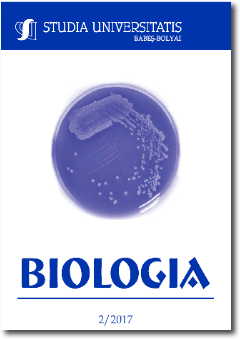Plant growth response and nitrate reductase activities of roots of “Chromolaena odorata” in a model spent lubricating oil-polluted soil
DOI:
https://doi.org/10.24193/subbbiol.2017.2.09Keywords:
bioaccumulation, Chromolaena odorata, enzymes, nitrate assimilation, nitrate reductase, phytoremediation.Abstract
The ability of Chromolaena odorata propagated by stem cuttings and grown for 50 days in the soil containing five (5) different concentrations of spent lubricating oil (SLO) in soil (0, 1, 3, 6, 9 and 12 % SLO), was investigated. The experiments were watered daily at 70% moisture field capacity. Parameters such as number leaves per plant, shoot length, plant height as well as nitrate reductase activities were measured. Shoot length as well as leaf number were significantly (p < 0.05) reduced, compared to the control treatment. Results also showed that nitrate reductase activities increased slightly with time. However, beyond 40 days, nitrate reductase activity was not detected in 3% - 12% w/w oil-in-soil treatments, respectively. Pollution indices such as Contamination factor and Hazard Quotient, used in the present study indicated significant reduction in contamination values upon sowing of C. Odorata. Values obtained from Bioaccumulation Quotients also indicated that the plant was able to significantly bioaccumulate elements such as Fe, Cu and Ni present in the SLO-polluted soil.
References
Adedokun, O.M., Ataga, A.E. (2007) Effects of amendments and bioaugumentation of soil polluted with crude oil, automobile gasoline oil, and spent engine oil on the growth of cowpea Vigna unguiculata, Sci. Res. Essay 25: 147-149
Adenipekun, C.O., Oyetunji, O.J., Kassim, L.Q. (2008) Effect of spent engine oil on the growth parameters, chlorophyll content of Corchorus olitorius Linn., Environmentalist 28: 446-450
Ajakaiye, C.O. (1987) Leaf nitrate reductase activity, crude protein in Corchorus olitorius L., Ceratoteca sesamoides esond, Nig. J. Botany 1: 36-42
Anoliefo, G.O, Vwioko, D.E., Mpamah, P. (2003) Regenerations of Chromolaena odorata L.K. & R. in crude oil polluted soil, a possible phytoremediation agent, Benin Science Digest 1: 9-16
Anoliefo, G.O., Isikhuemhen, O.S., Eghwrudjakpor, K.O., Iredia, H.O. (2006) Growth of Chromolaena odorata in crude oil polluted soil; an enhancement on the natural biodegradation process, Nigerian Journal of Botany 19(2): 360-376
AOAC (2005) Methods of Analysis. Association of Official Analytical Chemists, Washington D. C. Pp.326
Burzynski, M. (1987) The influence of lead, cadmium on the absorption, distribution of potassium, calcium, magnesium, iron in cucumber seedlings, Acta Physiol. Plant. 9: 229-238
Cal-EPA (2005) Air Toxics Hot Spots Program Risk Assessment Guidelines, Part II Technical Support Document for Describing Available Cancer Potency Factors, Office of Environmental Health Hazard Assessment, California Environmental Protection Agency, May (2005)
Cerqueira, N.M., Gonzalez, P.J., Brondino, C.D., Romão, M.J., Romão, C.C., Moura, I., Moura, J.J. (2009) The effect of the sixth sulfur ligand in the catalytic mechanism of periplasmic nitrate reductase, J. Comput. Chem. 30(15): 2466-2484
Efroymson, R.A., Will, M.E., Suter, G.W. (1997a) Toxicological Benchmarks for Screening Contaminants of Potential Concern for Effects on Soil, Litter Invertebrates, Heterotrophic Process, 1997 Revision. Oak Ridge National Laboratory, Oak Ridge, TN. ES/ER/TM- 126/R2 http,//www.hsrd.ornl.gov/ecorisk/reports.ht@
Efroymson, R.A., Will, M.E., Suter, G.W., Wooten, A, C. (1997b) Toxicological Benchmarks for Contaminants of Potential Concern for Effects on Terrestrial Plants, 1997 Retiision. Oak Ridge National Laboratory, Oak Ridge, TN, ES/ER/TM-85/R3 http,//www.hsrd.ornl.gov/ecoriskheports. html
Fan, X.H., Tang, C., Rengel, Z. (2002) Nitrate uptake, nitrate reductase distribution, their relation toproton release in five nodulated grain legumes, Ann. Bot. 90:315-323
Fedorova, E., Greenwood, J.S., Oaks, A. (1994) In-situ localization of nitrate reductase in maize roots, Planta 194: 279-286
Ghoulam, C., Foursy, A., Fares, K. (2002) Effects of salt stress on growth, inorganic ions, proline accumulation in relation to osmotic adjustment Amaranthus hybridus, Bio. Sci. Res. Comm 14:101-105
Henry, J.R. (2000) An Overview of Phytoremediation of Lead, Mercury. –NNEMS Report. Washington, D.C. pp. 3-9
Ikhajiagbe, B. (2010) Synergism in Bioremediation, Phytoassessment of Waste Engine Oil Polluted Soils after Amendment, Bioaugmentation, LAP Lambert Academic Publishing, Köln, Germany, pp.276
Ikhajiagbe, B., Anoliefo, G.O. (2012) Comparative phytotoxicity study of a waste engine oil-polluted soil exposed to different intervals of natural attenuation, Asian Journal of Experimental Biological Sciences 32: 335-343
Jackson, L.E., Burger, M.. Cavagnaro, T. R. (2008) Roots, nitrogen transformations, ecosystem services, Annu. Rev. Plant Biol. 59: 341-63
Lexa, M., Genkov, T., Brzobohaty, B. (2002) Inhibitory effects of elevated endogenous cytokinins on nitrate reductase in expressing tobacco are eliminated by short-term exposure to benzyladenine, Physiol Plantarum 115: 284-290
Mahan, J.R., Oliver, M.J., Sherman, T.D. (1998) Nitrate reductase activity during desiccation, rehydration of the desiccation-tolerant moss Tortula ruralis, Environ. Exp. Bot. 39: 67-76
Marschner, P. (2012) Marschner's mineral nutrition of higher plants, 3rd ed., Amsterdam, Elsevier/Academic Press, pp. 135
Rufty, T.W., Thomas, J.E., Remmler, J.L., Campbell, W.H., Volk, R.J. (1986) lntracellular localization of nitrate reductase in roots, Plant Physiol. 82: 675-680
Solomonson, L.P., Barber, M.J. (1990) Assimilatory nitrate reductase: functional properties and regulation, Annu. Rev. Plant Physiol. 41: 225-253
SSSA (1971) Instrumental Methods for Analysis of Soil, Plant Tissue. Soil Science Society of America, Corporated, Wisconsin, U.S.A, pp. 27-32
Stewart, G.R., Lee, J.A., Orebamjo, T.O. (1972) Nitrogen metabolism of halophyte, Nitrate reductase activity, utilization, New Phytol. 72: 539-546
Vaughn, K.C., Campbell, W.H. (1988) lmmunogold localization of nitrate reductase in maize leaves, Plant Physiol. 88: 1354-1357
Vwioko, D., Fashemi, S.D. (2005) Growth response of Ricinus communis L. Castor oil in spent lubricating oil polluted soil, J. Appl. Sci. Environ. Mgt. 92: 73-79
Wang, J., Jia, C.R., Wong, C.K., Wong, P.K. (2000) Characterization of polycyclic aromatic hydrocarbons created in lubricating oils, Water, Air,, Soil Poll. 120: 381-396
Whisman, M.L., Geotzinger, J.W., Cotton, F.O. (1974) Waste lubricating oil research, In: An Investigation of several Re-refining Methods. Bureau of Mines. Bartlesville, Energy Research Center, pp. 352
Downloads
Published
How to Cite
Issue
Section
License
Copyright (c) 2017 Studia Universitatis Babeș-Bolyai Biologia

This work is licensed under a Creative Commons Attribution-NonCommercial-NoDerivatives 4.0 International License.





